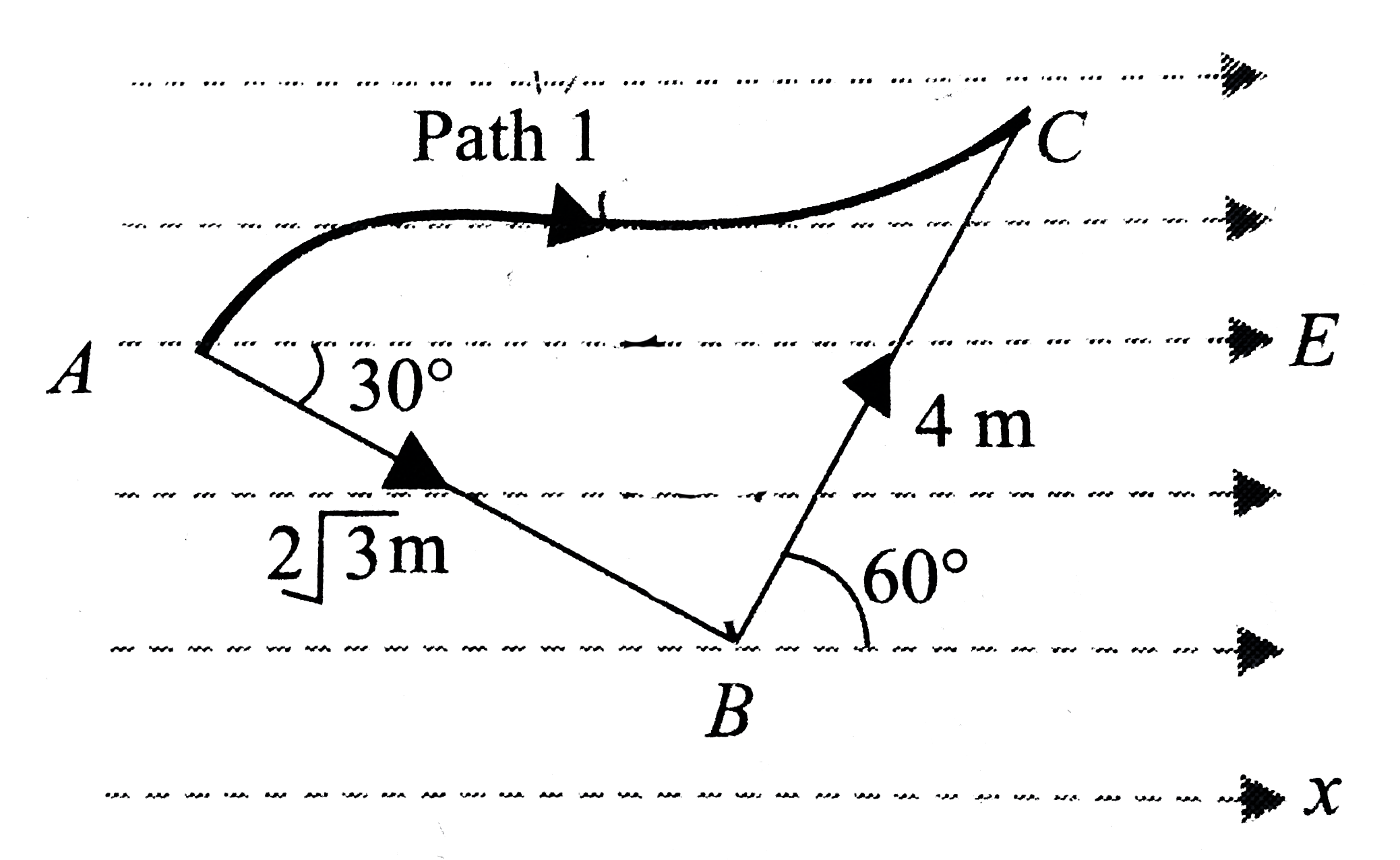A uniform electric fied exists in x-y plane. The potential of ponts A(2m,2m),B(−2m,2m) and C(2m,3m) are 4V,16V and 12V respectively. The electric field is
(4ˆi+5ˆj)V/m
(3ˆi+4ˆj)V/m
−(3ˆi+4ˆj)V/m
(3ˆi−4ˆj)V/m
The correct Answer is:D
To find the electric field in the given scenario, we can use the relationship between electric potential and electric field. The electric field →E is related to the electric potential V by the equation:
→E=−∇V
This means that the components of the electric field can be calculated as:
Ex=−dVdx,Ey=−dVdy
Step 1: Calculate Ex
We can find Ex by considering points A and B, where the y-coordinate remains constant. The coordinates are:
- A(2m,2m) with VA=4V
- B(−2m,2m) with VB=16V
Using the formula for Ex:
Ex=−VA−VBxA−xB
Substituting the values:
Ex=−4V−16V2m−(−2m)=−−12V4m=12V4m=3V/m
Step 2: Calculate Ey
Next, we calculate Ey using points A and C, where the x-coordinate remains constant. The coordinates are:
- A(2m,2m) with VA=4V
- C(2m,3m) with VC=12V
Using the formula for Ey:
Ey=−VC−VAyC−yA
Substituting the values:
Ey=−12V−4V3m−2m=−8V1m=−8V/m
Step 3: Write the Electric Field Vector
Now that we have both components of the electric field, we can write the electric field vector →E:
→E=Ex^i+Ey^j=3^i−8^jV/m
Final Answer
The electric field is:
→E=3^i−8^jV/m
---
- A(2m,2m) with VA=4V
- B(−2m,2m) with VB=16V
- A(2m,2m) with VA=4V
- C(2m,3m) with VC=12V
Topper's Solved these Questions
- BOOK - DC PANDEY ENGLISHCHAPTER - ELECTROSTATICSEXERCISE - Exercise 24.14videos
ELECTROSTATICS
- BOOK - DC PANDEY ENGLISHCHAPTER - ELECTROSTATICSEXERCISE - Exercise 24.29videos
ELECTROSTATICS
- BOOK - DC PANDEY ENGLISHCHAPTER - ELECTROSTATICSEXERCISE - Example Type 83videos
ELECTROSTATICS
- BOOK - DC PANDEY ENGLISHCHAPTER - ELECTROSTATIC POTENTIAL AND CAPACITORSEXERCISE - (C) Chapter exercises50videos
ELECTROSTATIC POTENTIAL AND CAPACITORS
- BOOK - DC PANDEY ENGLISHCHAPTER - GRAVITATIONEXERCISE - All Questions135videos
GRAVITATION
Similar Questions
A uniform electric field exists in x−y plane. The potential of points A(−2m,2m),B(−2m,2m) and C(2m,4m) are 4V,16V and 12V respectively. The electric field is
View SolutionA uniform electric field is along x-axis. The potential difference VA−VB=10V is between two points A (2m, 3m) and (4m, 8m). Find the electric field intensity.
View SolutionThe standard electrode potentials (E∘M+/M) of four metals A, B, C and D are −1.2V,0.6V,0.85Vand−0.76V, respectively. The sequence of deposition of metals on applying potential is
View SolutionThe electrode potentials for M2+(aq)+e−→M+(aq) and M+(aq)+e−→M(s) are 0.25 V and 0.60 V respectively.The value of E∘_M2+M is
View SolutionThe velocities of our molecules are V, 2V, 4V and √2V, respectively. Their r.m.s. speed is
View SolutionFind the potential difference VAB between A(2m,1m,0) and B(0,2m,4m) in an electric field,
E=(xˆi−2yˆj+zˆk)VmView SolutionAn electric field →E=Bxˆi exists in space, where B=20V/m2. Taking the potential at (2m, 4m) to be zero, find the potential at the origin.
View SolutionAssume that an electric field →E=30x2ˆi exists in space. Then the potential differences VA−V0 where V0 is the potential at the origin and VA, the potential at x=2m is
View SolutionAn electric field →E=→IAx exists in the space, where A=10Vm−2. Take the potential at (10m, 20m ) to be zero. Find the potential at the origin.
View SolutionIn a certain region, electric field E exists along the x - axis which is uniform. Given AB=2√3m and BC=4m. Points A, B, and C are in xy plane.
 .
.
find the potential difference VC−VB between the points CandB.View Solution

